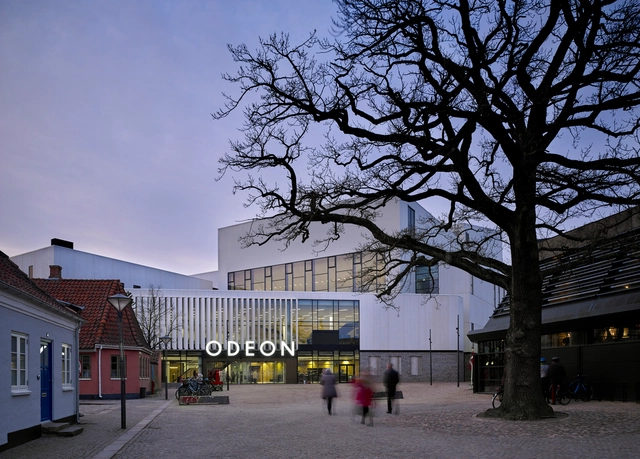
Odense: The Latest Architecture and News
Norlys Charging Park Drejebænken / ADEPT
H.C. Andersen Garden by MASU Planning Wins the Danish Landscape Award 2023

The Danish Landscape Award 2023 has been awarded to the H.C. Andersen Garden, designed by MASU Planning. The award focuses on honoring landscape architectural works with character, serving as “inspiration” for the industry. Situated in Odense in Denmark, this year’s winner was praised for reviving urban renewal in the city center by creating an escape that blends with the existing context.
H.C.Andersen Hus Museum / Kengo Kuma & Associates

-
Architects: Kengo Kuma & Associates
- Area: 5600 m²
- Year: 2022
-
Professionals: Søren Jensen Engineering Consultants A/S, MASU Planning
Cortex Park / CREO ARKITEKTER A/S + ADEPT

-
Architects: ADEPT, CREO ARKITEKTER A/S
- Area: 7500 m²
- Year: 2015
-
Manufacturers: Hunter Douglas Architectural (Europe), Graphic Concrete, Hunter Douglas, Linit-glass
-
Professionals: Ramboll, Schul Landskab
Kengo Kuma Designs Hans Christian Andersen's Museum in Denmark

Scheduled to open in the summer of 2021, the H.C. Andersen’s House is a new museum, designed by Kengo Kuma & Associates in Odense, Denmark. Reinterpreting the story of the Danish author’s life and work, the project “will provide a unique artistic experience, which combines landscape, architecture and modern exhibition design”.
3XN Unveils Design For New Robot Developers Hub

Denmark-based 3XN Architects has unveiled their design for a new Robot Developers Hub in Odense, Denmark. Designed as the new home of Universal Robots (UR) and Mobile Industrial Robots (MiR), the 20,000 square-meter hub will offer specialised environments for robot research and development.
Odense Music and Theatre Hall / C.F. Møller
Thorvald Ellegaard Arena / Mikkelsen Architects

-
Architects: Mikkelsen Architects
- Area: 7200 m²
- Year: 2014
-
Manufacturers: HANS JØRGENSEN & SØN Entreprenører A/S, Junek Velodromes, Taiyo
Byens Bro Foot and Cycle Bridge / Gottlieb Paludan Architects

-
Architects: Gottlieb Paludan Architects
- Year: 2015
-
Manufacturers: Bladt Industries, Chrisscoating, Hagemeister, Steffen Sten, Steffen Sten and Hagemeister
-
Professionals: ES-Consult, Niras, Bartenbach
Kengo Kuma and Cornelius+Vöge Release Plans for Hans Christian Andersen Museum in Odense

Kengo Kuma & Associates, in a team with Cornelius+Vöge and landscape architects MASU planning, have revealed plans for the Hans Christian Andersen Museum in Odense, Denmark. Channeling the otherworldliness of Andersen’s fairy tales, the 5,600 square meter building is two-thirds below grade, leaving ground level space for “enchanted” gardens of large trees, lawns, box hedges, and tall shrubs. The museum building is an ambling collection of cylindrical volumes, with glass and lattice timber facades beneath scooped green roofs, all surrounding a sunken courtyard space. The project will replace an existing museum that is largely focused on the author’s personal life with one that is more centered on his stories.
Student Housing / C.F. Møller

-
Architects: C.F. Møller
- Area: 13700 m²
- Year: 2015
-
Professionals: C.F. Møller Architects, Niras
HF & VUC Fyn complex / CEBRA
Odense Cathedral High School / Cubo Arkitekter

-
Architects: Cubo Arkitekter
- Area: 3000 m²
- Year: 2013
-
Professionals: EBD Arkitekter Aps, Lemming & Eriksson
North Atlantic House / Cornelius + Vöge

-
Architects: Cornelius + Vöge
- Area: 3800 m²
- Year: 2013
-
Manufacturers: VMZINC
-
Professionals: Hans Jørgensen & søn
Adult Education Center / CEBRA

Danish firm, CEBRA, was recently awarded first prize for their new education center in Odense. The building explores how curved forms can penetrate and define the rectilinear confines of the 134,550 sqf school building. Soft curving levels open to floors below and provide a mixing of visual and auditory experiences in a dynamically changing environment. Moreover, such levels provide a flexible learning environment, with “the human-being placed at the center.”
More about the project after the break, including CEBRA’s awesome hand renderings.
Thomas B. Thriges Gade 2012 - 2020
Denmark's third largest city, Odense, has a major transformative plan for their city center by 2020. In the 1960s, the Thomas B Thriges Gade allowed Odense to accomodate the demands of growing vehicular traffic, but since then, the city has been hard pressed to break from this defining infrastructure. Utopian City Scape and Entasis have teamed to create a multi-stage development plan for the city center as a way to restore the cohesiveness of a city that has been fragmented by the Thomas B Thriges. The plan sees the introduction of a massive amount of building (more than 55,000 sqm!) that will provide over 300 housing opportunities and 1000 work places. By filling in the street, the smaller networks of secondary streets will be strengthened to create pedestrian passageways and prominades, creating intimate moments that become defined by the edges of the buildings. While we enjoy the light rail system that works its way around the city center, the idea of including a parking lot that accommodates nearly 1000 vehicles seems a bit contradictory. Perhaps, without it, citizens would rely move heavily upon the public infrastructure and the new "connected" feeling of the city to circulate. The absence of cars would further strengthen Odense's move away from a city defined by the vehicle and would allow the master plan to implement its sustainability theme on a macro level.















































































